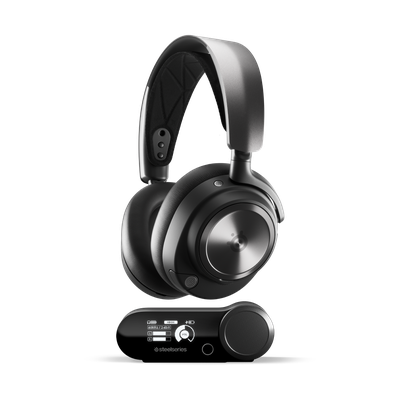The GameDAC Gen 2 is an extremely powerful device that upgrades your audio experience. But how does it do that? What kind of difference can it make? Let's dive in.
Our newly released Arctis Nova Pro gaming headset is packed with awesome features that elevate your audio experience to new levels. It uses a powerful combination of hardware and software to give you an amazing, immersive sound experience no other headset has before. What sets this offering apart from others is the GameDAC Gen 2.
You may have seen our GameDAC device before if you've purchased our Arctis Pro; however, the Gen 2 version of the GameDAC takes it even further. This is not only a device that informs you about your headset and lets you control your audio experience; it features a built-in amplifier. So what does it actually do for you?
What is a GameDAC?
First of all, DAC stands for Digital to Analog Converter. As pretty much almost all audio we hear nowadays comes from digital sources, it needs to go through that conversion before it can be played through the headset. Your game controllers, motherboards, and USB headsets are all equipped with such chips, though they vary in quality.
The thing is, some DACs are better at converting the audio than others. There's a certain amount of distortion and noise is generated with this process, not loud enough to hear distinctly, but affecting the fidelity of the sound. The best DACs use high-precision components, meticulous design, and intricate manufacturing processes -- even small upgrades to performance can sometimes mean big jumps in cost.
This is expressed with a metric called Signal to Noise Ratio (SNR) and is measured in decibels, such as 111 dB.
The leap with GameDAC Gen 2
Want to be in on the secret? The big difference in the GameDAC Gen 2 lies in the chip.
We collaborated with a world-leading company to deliver an audiophile-level experience with the headset (when we say Almighty Audio, we really mean it). Your Arctis Nova Pro headset works with GameDAC Gen 2's ESS Sabre Quad-DAC chip.
The key word there is "quad," as the this chip has four times as much power as the singular one included in our GameDAC Gen 1. They work in symphony for an even better audio experience. Each additional DAC serves to further reduce distortion and noise, raising the SNR spec and ultimately, the audio quality.
As a result, the conversion is even cleaner, with the new generation bringing you ultra-low levels of noise and distortion. This is backed up by the signal-to-noise ratio, or SNR. Our GameDAC Gen 2 scores 111 dB, which is on the high-end of these devices. Think of it this way -- the higher the SNR, the further away you are from the noise "floor," adding more fidelity and clarity to your sound.
You can rest assured that you're using a top-tier device that's usually found in audio enthusiast equipment, with much purer sound and greater detail that lets you enjoy the soundscape much more.
Wynik: Hi-Res Audio
You may have seen the yellow Hi-Res Audio badge on high quality home audio products, but what does it mean? Essentially, it tells you that a given piece of gear is capable of handling high quality audio formats with wider frequency ranges. There are two numbers that make up an audio format: the sampling rate and the bit depth.
Sampling rate tells you how many data samples per second make up the audio stream. The higher the number, the more points and more detail. Most games and audio streaming run at 48 kHz (48 000 samples) per second. Hi-Res formats however, run at 96 kHz, or double the number of samples. This also means that the audio can cover a wider frequency range (up to 40 000 Hz vs 20 000 with standard formats). This is why the speaker drivers in the Arctis Nova Pro have been carefully crafted to produce such high frequencies, so you can enjoy every last Hertz of your Hi-Res audio!
Arguably, bit depth has an even greater effect on the quality of your audio. Bit depth tells you the number of bits that are used to define each audio sample. The more bits you have, the greater the detail of the audio stream. Think of it like a screen using more pixels to define an image. The more you have, the better the detail. Again, games and standard audio streaming typically run at 16 bit, but Hi-Res audio uses 24 bit, which can make a huge difference.
If you're ready to venture into the world of Almighty Audio, hear the difference with the Arctis Nova Pro gaming headset.






